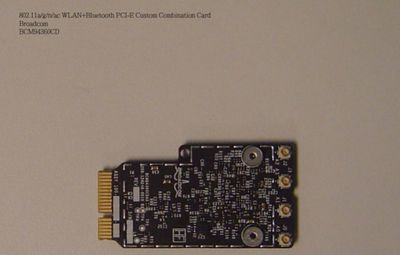Photos of Likely 802.11ac 'Gigabit Wi-Fi' Card From Next-Generation iMac Surface
Tonymacx86 points (via 9to5Mac) to recently discovered photos of a Broadcom BCM94360CD Wi-Fi/Bluetooth card that supports the 802.11ac "Gigabit Wi-Fi" standard rumored to be coming to Apple's Mac lineup later this year. While the photos were posted to Chinese site VR-Zone in early March, they are only just now being noticed by those following Apple rumors.

While the reports suggest that the new card is intended for the next-generation MacBook Pro or MacBook Air models rumored for launch at next month's Worldwide Developers Conference (WWDC), a commenter on the Tonymacx86 discussion thread points out that the card is actually nearly identical in size, shape, and layout to the Wi-Fi/Bluetooth card found in the current iMac.

The BCM94360CD card, which is very likely a custom design for Apple, contains Broadcom's BCM4360 802.11ac transceiver chip, offering support for the in-process Wi-Fi standard that allows for triple the speeds of the current 802.11n standard. An apparent date code of "1240" on the part suggests that it was manufactured in early October 2012, several months before Apple was reported to have struck a deal with Broadcom to bring 802.11ac support to its 2013 Macs.

Wi-Fi/Bluetooth card from Late 2012 iMac (Source: iFixit)
Popular Stories
Apple will adopt the same rear chassis manufacturing process for the iPhone SE 4 that it is using for the upcoming standard iPhone 16, claims a new rumor coming out of China. According to the Weibo-based leaker "Fixed Focus Digital," the backplate manufacturing process for the iPhone SE 4 is "exactly the same" as the standard model in Apple's upcoming iPhone 16 lineup, which is expected to...
Apple typically releases its new iPhone series around mid-September, which means we are about two months out from the launch of the iPhone 16. Like the iPhone 15 series, this year's lineup is expected to stick with four models – iPhone 16, iPhone 16 Plus, iPhone 16 Pro, and iPhone 16 Pro Max – although there are plenty of design differences and new features to take into account. To bring ...
A widespread system failure is currently affecting numerous Windows devices globally, causing critical boot failures across various industries, including banks, rail networks, airlines, retailers, broadcasters, healthcare, and many more sectors. The issue, manifesting as a Blue Screen of Death (BSOD), is preventing computers from starting up properly and forcing them into continuous recovery...
Israel-based mobile forensics company Cellebrite is unable to unlock iPhones running iOS 17.4 or later, according to leaked documents verified by 404 Media. The documents provide a rare glimpse into the capabilities of the company's mobile forensics tools and highlight the ongoing security improvements in Apple's latest devices. The leaked "Cellebrite iOS Support Matrix" obtained by 404 Media...
Apple is seemingly planning a rework of the Apple Watch lineup for 2024, according to a range of reports from over the past year. Here's everything we know so far. Apple is expected to continue to offer three different Apple Watch models in five casing sizes, but the various display sizes will allegedly grow by up to 12% and the casings will get taller. Based on all of the latest rumors,...
If you have an old Apple Watch and you're not sure what to do with it, a new product called TinyPod might be the answer. Priced at $79, the TinyPod is a silicone case with a built-in scroll wheel that houses the Apple Watch chassis. When an Apple Watch is placed inside the TinyPod, the click wheel on the case is able to be used to scroll through the Apple Watch interface. The feature works...























